
Figure N° 1. Survey form
Source: Prepared by the authors
______________________________________________________________________________________________________________________________________________
Visión de futuro
REVISTA CIENTIFICA ISSN 1668 - 8708 VERSION EN LINEA
URL DE LA REVISTA: http://visiondefuturo.fce.unam.edu.ar/index.php/visiondefuturo/index
E-mail: revistacientifica@fce.unam.edu.ar _____________________________________________________________________________________________________________________________________________
AÑO 17, VOLUMEN 24 N° 2, JULIO - DICIEMBRE 2020
URL DEL DOCUMENTO: http://visiondefuturo.fce.unam.edu.ar/index.php/visiondefuturo/issue/view/18
Los trabajos publicados en esta revista están bajo la licencia Creative Commons Atribución-NoComercial 2.5 Argentina
ENVIRONMENTAL ANALYSIS OF UNIVERSITY STUDENTS’ MODE OF TRANSPORTATION AND PAPER CONSUMPTION
María José Fernández; Verónica García Fronti; Andrea Parma
_____________________________________________________________________________________________________________________________________________________________
Environmental analysis of university students’ mode of transportation and paper consumption
(*)María José Fernández; (**) Verónica García Fronti; (***) Andrea Parma
(*) University of Buenos Aires
School of Economics
Buenos Aires, Argentina
mariajfernandez@economicas.uba.ar
(**) University of Buenos Aires
School of Economics
Buenos Aires, Argentina
vgarciafronti@economicas.uba.ar
(***) University of Buenos Aires
School of Economics
Buenos Aires, Argentina
andreaparma38@gmail.com
ABSTRACT
The activities undertaken in educational organizations have a certain environmental impact. Analyzing their effect on the environment makes it possible to determine and prioritize actions aimed at minimizing it. One way to quantify such effect is by means of the Ecological Footprint environmental indicator, which has a high potential when used as an awareness-raising tool.
These types of organizations have a high level of paper consumption. In addition, students commute to their campuses, thus involving an intensive use of transport systems (trains, subway, buses, bicycles, and private cars).
In order to calculate the Ecological Footprint indicator, a survey responded to by students of the ‘Mathematical Analysis II’ subject at the School of Economics of the Universidad de Buenos Aires was carried out, so as to determine their paper consumption and the mode of transportation used to attend their classes. Based on these data, the environmental impact of this activity was calculated.
This paper describes the methodology used and presents the results obtained for these two environmental aspects: paper consumption and students’ transport.
KEY WORDS: University environmental management; Ecological Footprint; Indicators.
INTRODUCTION
The Ecological Footprint indicator makes it possible to analyze and explore the environmental impact caused by human activities at a global, national or organizational level. Although this indicator is not widely used at this lowest level, within the sphere of a university institution, it has a high potential when used as an awareness-raising tool. It makes it possible to know how university activities impact on the environment.
Universities that have applied this indicator are mostly from English-speaking countries. Some universities from Spain have also used it, such as the University of Malaga (Universidad de Malaga, 2016).
In this sort of organizations, the activities conducted result in a high consumption of paper. In addition, the journey of university communities towards campuses involves an intensive use of transport networks (trains, subway, buses, bicycles and private cars).
With the objective of calculating the Ecological Footprint indicator, a survey was carried out in 2016, responded to by students of ‘Mathematical Analysis II’ at the School of Economics of the University of Buenos Aires. In this way, paper consumption and type of transport were determined for this group of students.
In a first phase, the Ecological Footprint sustainability indicator and the feasibility of its application to the FCE-UBA (Fernandez et al., 2017) were researched. Two of the partial indicators included in the Ecological Footprint, namely paper consumption and student transport, were studied. The assessment methodology was defined and a survey for students on their paper consumption habits and mode of transportation was designed.
In this paper, progress was made in a second stage, and the results of the first exploration concerning students are presented.
DEVELOPMENT
Methodology
To analyze the sustainability of human activities, Wackernagel and Rees (2001) proposed the approach used to address this research. Its objective is to render more visible the pressure exerted by these activities on the natural ecosystem in which they develop. To achieve this, the authors designed a biophysical indicator called Ecological Footprint (EF) and proposed a methodology for its calculation. This approach will be used in this article.
The EF indicator quantitatively evaluates the impact of human activities in terms of ecosystem productive areas. Thus, EF expresses the area needed to produce the resources used and to assimilate the waste caused by a population in a given period of time and place. It is a single (integrated) index and descriptive indicator yielding how many hectares of nature are needed to supply production processes and to absorb the waste caused by an economy (Wackernagel and Rees, 2001).
The Ecological Footprint is generally expressed in global hectares per person and year. Therefore, it will depend on two factors: on the one hand, the lifestyle of the individual analyzed, i.e. his/her consumption habits, and, on the other, the necessary ecological system to generate those resources and assimilate the waste caused.
Wackernagel and Rees (2001) defined five categories of consumption, that is to say, five ways in which we use natural resources: food, housing, transportation, consumer items and services. In this way, partial indicators according to each category analyzed form the EF indicator. In this paper, we will study two partial indicators that are comprised by EF: one associated with the students’ transportation towards their university campuses, and the other, with the paper consumption for studying purposes. While both categories determine a partial Ecological Footprint, calculation methodologies differ conceptually. Then, both methodologies are briefly described.
Partial ecological footprint of students’ mode of transport
To calculate the partial EF for mode of transport, the method chosen is the one that estimates the area of land required to seize the CO2 from the fuel combustion of the different means of transport used (Wackernagel and Rees, 2001).
This method takes into account that forests accumulate CO2 at a very high rate over periods ranging from 50 to 80 years. Data on the average forest productivity of temperate, boreal and tropical forests show that average forests can accumulate approximately 1.8 tons of CO2 per hectare per year (Wackernagel and Rees, 2001).
In this way, per-capita transport Ecological Footprint transport EF will be determined by first calculating the amount of CO2 emissions from fossil fuel consumption, and then these emissions will be divided by the fixing factor (1).
Per-capita transport Ecological Footprint (ha/year) = Emission (ton CO2) (1)
Mean Fixing CO2 (ton CO2/ ha/year)
Partial Ecological footprint of paper consumption
The printable or writing paper that we use comes from the consumption of a renewable natural resource such as cellulose. Cellulose can be of forest or vegetal origin. In both cases, the main inputs for its manufacture are, in addition to cellulose, energy and water used in the paper-making process.
The paper Ecological Footprint (paper EF) indicator is based on the idea that, for each ton of paper consumed, a certain amount of land is required to provide the basic resource (cellulose). In this case, the paper production process is not analyzed, so considerations on energy and water consumption are not included in the indicator.
To calculate the per-capita paper EF indicator, the first item to be obtained is the weight in tons of the paper consumed by each student during a year. For this, a survey asking students about their main paper consumption for studying purposes —use of notebooks, own print-outs and photocopies— was conducted. In this way, the average annual consumption per capita of the surveyed students is calculated.
The next step is to estimate the per capita surface area for the production of the paper consumed. For this, the average annual paper consumption is divided by its average annual productivity. The per-capita paper EF is calculated as follows (2):
Per-capita paper EF (ha/year) = Per-capita annual consumption of paper (ton) (2)
Annual productivity (ton / ha)
To assess the paper productivity in Argentina, data from the city of Tandil were used. These data were published on the paper: Spatial indicator of urban metabolism. Ecological Footprint of the city of Tandil, Argentina, authored by Guerrero and Guiñirgo in 2008. In this paper, it is considered that pine trees are used to produce cellulose pulp.
Partial EF calculation
The procedure to calculate both partial indicators makes it possible to become aware of the impact exerted by students when journeying and consuming paper to undertake their university activities.
As mentioned, when describing the calculation method for partial EFs, in order to know the students’ modes of transportation and consumption habits, a survey was conducted in 2016 in four Mathematical Analysis II courses at the School of Economics of the University from Buenos Aires.
The survey was managed through a form accessible from the institutional virtual campus of the School. The only participants in this virtual classroom are the students enrolled in the subject and the professors in charge of it. The survey was anonymous and its completion was optional. Before joining this platform, the professor in charge of each course explained the purpose of the survey and the concept of EF.
The survey consisted of 12 questions. The first 6 questions were related to the characterization of the undergraduates surveyed; questions 7 to 9 were related to transport; and the remainder (questions 10 to 12), to paper consumption (Figure 1).

Figure N° 1. Survey form
Source: Prepared by the authors
The School of Economics has several headquarters distributed in the City of Buenos Aires and Greater Buenos Aires, where accesses are available by various public transport networks (bus, train, subway, etc.). The School does not have a campus with accommodation, so students must commute every time they attend classes.
As regards paper, its consumption by students is associated with the notes acquired at the School’s photocopying shop and the university-size notebooks bought. In general, although the learning materials are available electronically, undergraduates often use them in paper format and complement their use with other files in electronic format.
The considerations concerning the two aspects reviewed —fuel used for transport and paper used by students— will be described below.
Transport
Greenhouse gas (GHG) emissions attributable to the use of fossil fuels have shown a direct contribution to the increase in regional temperature in proportions greater than those that would have occurred naturally. Of these, the most relevant ones deriving from the transport sector are carbon dioxide (CO2); methane (CH4) and nitrous oxide (N2O)
For the calculation of emissions by type of pollutant, the equation used in this paper (Tuia et al., 2007) is the following (3):
Ec= åj NjMjFEjc (3)
Where:
EC: emission of pollutant criterion c in grams during the chosen unit of time (grs/time),
Nj: vehicles of type j (Number of vehicles),
Mj: kilometers traveled by all vehicles of type j per unit of time (km/time),
FEjc: emission factor associated with the vehicle of type j for pollutant c (grs/km).
The equation indicates that the total amount of emissions of a given pollutant is a function of the number of vehicles considered in the analysis, as well as the total distance traveled by each and the emission factors associated with each type or vehicle category. This paper will only focus on CO2 emissions.
As mentioned above, data related to the type of vehicle used by students to commute to their university campuses were collected. They were classified as private vehicles, motorcycles, buses, bicycles or on foot, subway and trains. In addition, to know the distance covered, they were consulted about the origin and destination of these trips and if they shared private vehicles.The following equation is used to process the data collected, which is an extension of Equation (3):
Eco2 = åi=1N Vi Di FEiCO2 (4)
Where
i: survey number.
N: total amount of surveys.
ECO2: CO2 emissions in grams during the week of school activities (grs/week).
Vi: number of journeys made by the vehicle of the ith survey in a week (journeys/week).
Di: distance traveled in kilometers in each journey of the vehicle of the ith survey (km/journey).
FEic: IVE emission factor associated with survey vehicle i for CO2 (grs/km).
Each of the N surveys is processed separately, yielding one result per survey for each of the required variables in the evaluation of total emissions (EC). The number of trips per vehicle (Vi) is estimated from the question about the number of journeys to the institution during the week. The kilometers traveled by each type of vehicle (Di) are estimated using a free-access geographic information system (Google Earth), making a query of the distances between the starting point of the journeys and the institution. Pollutant emission factors for private vehicle types and motorcycles (FEic) are considered according to each vehicle per survey.
The CO2 emission factors used in this study are expressed in Table 1.
Table N° 1. CO2 emission factors

Source: Data obtained from the Urban Transport Observatory (OMU)
It is assumed that 100% of the car-type vehicles use gasoline as fuel, because those which use diesel are insignificant. The 2012 energy inventory in the transport category does not compute passenger cars running on diesel.
Once CO2 emissions have been obtained, and knowing the average fixation factor, the trasnport Ecological Footprint per capita, previously stated in (1), is calculated.
Paper
To calculate the paper EF of students taking Mathematical Analysis II, first of all, we examined the students' consumption of paper per semester through a survey. They were consulted about the three predominant categories of paper consumption in university activities: number of notebooks used for lessons, photocopies made and sheets of paper printed.
As regards notebooks, students mainly use those with the following characteristics: soft cover spiral, containing 84 pages of 65 gr / m2 and a size of 223 x 295 mm. The paper for other uses, both for the photocopying shop and for printing at home, weighs 75 gr / m2 and its dimensions are 210 x 297 mm (A4).
To determine the partial Ecological Footprint for paper consumption, (2) is used. To perform this calculation, it is necessary to know the paper consumption in tons. To do this, we propose two procedures that convert the number of notebooks and sheets used by students into tons of paper. The following conversion factors analyzed in Fernandez et al., 2017 are used to perform this conversion:
Ton of paper for each notebook used= 0.065(kg/m2) * 84pages (5)
15.15 (pages/m2) * 1000(kg/tn)
Ton of paper for each notebook used = 0.00036 (tn/notebook) (6)
Ton of paper for each sheet used = 0.08 (kg/m2) (7)
16.033 (sheet/m2) * 1000(kg/tn)
Ton of paper for each sheet used = 0.000005 (tn/sheet) (8)
Additionally, to determine productivity, it was assumed that, on average, in order to produce 1 ton of paper, 2 m3 of wood are needed (Guerrero and Guiñirgo, 2008). The average forest ecological productivity to be applied is the one proposed by Wackernagel and Rees (2001), which is 2.3 m3 of usable wood fiber per hectare per year. That is, the productivity will be:
Annual productivity (ton/ha) = 2.3 (m3/ha) = 1.15 ton (9)
2 (m3 / tn) ha
Productivity tells us the number of tons of cellulose fiber we can obtain in one hectare of forest land. In the following section, we will use these factors to calculate the paper EF, using equation (2).
Results
Population characteristics
The survey focused on four courses of Mathematical Analysis II. This subject is taught in the first and second terms of the Degree in Economics, Actuary in Economics and Actuary in Management at the School of Economics of the University of Buenos Aires. There were 375 students enrolled in that four-month period in the courses under study.
The following data analyzed reflect the answers obtained from the online questionnaire completed by 109 students. On average, each interviewee took 3 minutes and 23 seconds to complete the survey.
The data file of the survey is as follows:
Regarding the courses of study, 66% are students of the Degree in Economics, 17% of Actuary in Economics, and 17% of Actuary in Administration.
Of the total respondents, 68% attend the Paternal campus and 32% attend the Córdoba Campus. Both are located in the City of Buenos Aires, in the neighborhoods of La Paternal and Balvanera, respectively.
Fifty-seven percent of the students surveyed have a job and have passed, on average, 9 subjects out of a total of 34.
Sixty-three percent of the students attend classes in the morning (7 am to 1 pm), and the rest, in the afternoon (1 pm to 7 pm) and evening (7 pm to 11 pm).
Transport-related results transport
Of the 109 students surveyed, as shown in Figure 1, the highest percentage of the student population uses Public Transport to go to their campuses (85%). Secondly, with a much lower percentage, Personal Transport (11%) is used, and finally 4% cycles or walks to the campuses.
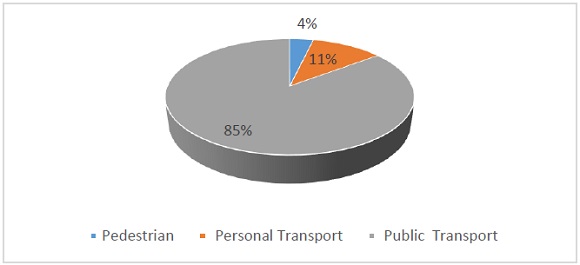
Graph N° 1. Type of transportation used by students
Source: total cases (109 respondents)
As students come not only from different parts of the City of Buenos Aires, but also from towns in the Buenos Aires metropolitan area, the percentage of students going on foot or by bicycle is significantly low. In addition, both campuses are well connected with various types of public transport, and it is cheaper to use this means.
Table 2 and graph 2 detail the type of public transport used by the students surveyed with greater specificity.
Table N° 2. Means of transport used

Source: total cases (109 respondents)
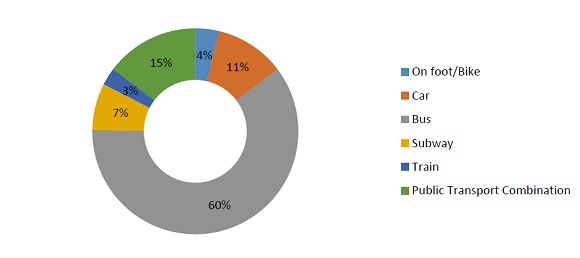
Graph N° 2. Means of transport used
Source: total cases (109 respondents)
One of the campuses does not have access through the subway, so the bus is the most widely used mode of transportation.
To process the information in Table 3, the capacity of the means of transport was considered, taking into consideration that all passengers are seated. In the case of trains, this differs according to the Line (Mitre-Roca-San Martín and Urquiza). The data used come from the FA (Argentine Railways) database. In the case of the subway, the Fiat car, with a capacity of 41 seated and 129 standing passengers, that is a full load of 170 passengers, was considered in this paper. For a 5-car train, the maximum load is 850 people (SBASE - Subways of Bs. As.).
The buses in the City of Buenos Aires have, in general, a capacity of 33 seated passengers and 50 passengers as maximum load (CEAP, Argentine Passenger Transport Business Chamber). For cars, the minimum capacity is 1 and the maximum capacity was considered to be 4 passengers.
The CO2 emission factor, as we have already mentioned, is directly related to the type of transport and the number of passengers sharing the journey.
Thus, the following table shows the variations in the emission factor per km and per person for the different modes of transportation and the different capacity scenarios that may arise.
Table N° 3. Emission factors
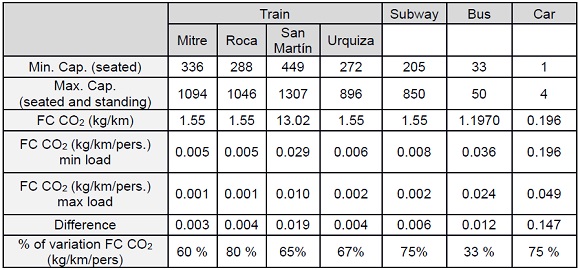
Source: Prepared by the authors based on FA-CEAP-SBASE
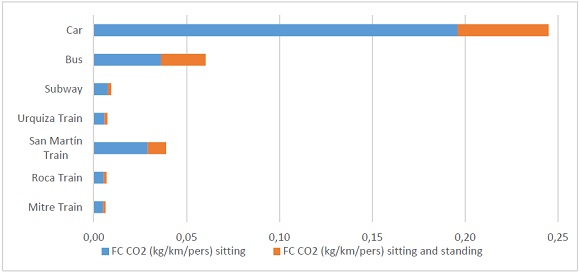
Graph N° 3. CO2 Emission Factor (kg/km/pers.)
Source: Prepared by the authors based on table 3
CO2 Emission
To calculate the CO2 emission (ECO2) caused by the transport of the students surveyed, formula (4) stated in Section 2.3.1 was considered.
CO2 weekly emissions were calculated for the students surveyed in relation to the amount of km covered from their homes to the university campuses, considering the number of journeys made weekly and the emission factor associated with the transport used. Some students combine two types of transportation and, for those cases, the calculation was partitioned. Thus, ECO2 = 404.8 kg CO2 / week was obtained. To calculate the annual CO2 emission, each four-month period was considered to last 12 weeks, totaling 32 weeks during the year. Therefore, for 2018, when the survey of 109 students from the Paternal and Córdoba campuses of the FCE - UBA was carried out, an emission of: ECO2 = 12953.54 kg CO2 / year was totaled. Therefore, each student emitted, on average, 118.84 kg / individual / year.
To compare the carbon dioxide emitted by 400 students with the emissions of certain industrial sectors, such as the steel industry, which, on average, emits 0.267 tn CO2 / tn product, the annual CO2 emission of the 400 students to commute to their university campuses would be equivalent to the carbon dioxide produced to manufacture 118 tons of steel. In the case of the cement industry, which, on average, emits 0.745 tn CO2 / tn product, the CO2 emission produced by the students would be equivalent to the production of 63 tn of cement.
Table 4compares the CO2 emissions, taking into account different means of transport and the population studied. The analysis of the data collected shows that the students commute, on average, 4 times a week to study their subjects, and the average distance traveled is 11.34 km.
In general, students commute at rush hours to university campuses; thus the public transport load is assumed to be maximum. At the city level, the emission of carbon dioxide is higher, since the number of vehicles that circulate increases (greater frequency of public transport and more private vehicles).
This comparison shows the great difference between the use of cars and buses, and also the big difference between the emissions of buses and the subway. Obviously, this is due to the difference between the emission factors and the carrying capacity of each vehicle.
Table N° 4. CO2 Emissions (kg/km/pers.) in relation to load capacity
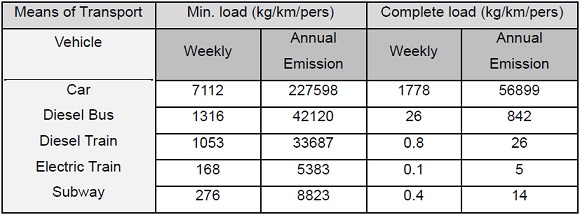
Source: Prepared by the authors
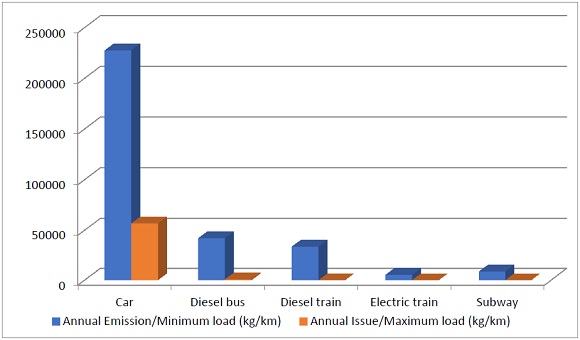
Graph N° 4. Comparison Annual CO2 emissions for minimum and maximum load
Source: Prepared by the authors
Transport Ecological footprint
Finally, the per-capita transport Ecological Footprint Indicator is calculated. This studies the impact of the means of transport used by students to commute to their university campuses, in terms of productive areas of ecosystems.
This indicator is calculated using formula (1). The average carbon fixation for a forest-type land is estimated at 1.8 tnC / ha / year (Wackernagel and Rees, 2001), which, translated into CO2 fixation, is equivalent to 6.6 tn CO2 / ha / year. The corresponding calculation for 400 students yields an Ecological Footprint of 7.2 ha / year. Therefore, 7.2 ha of forest-type land are needed to assimilate the carbon dioxide emitted by the 400 students of Mathematical Analysis II for a period of one year.
Paper consumption results
Paper is the main input used by students to undertake their academic activities, either to take notes or to use photocopies and print documents. To calculate their consumption, as already mentioned, we asked students about the use of university notebooks, printed and photocopied sheets. The purchase of printed books was not included in the analysis of this study.
With regard to the notebooks used by the students in a four-month period, the following results were obtained:
Table N° 5. Use of notebooks in a term
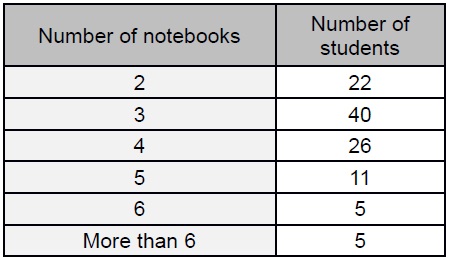
Source: Total cases (109 respondents)
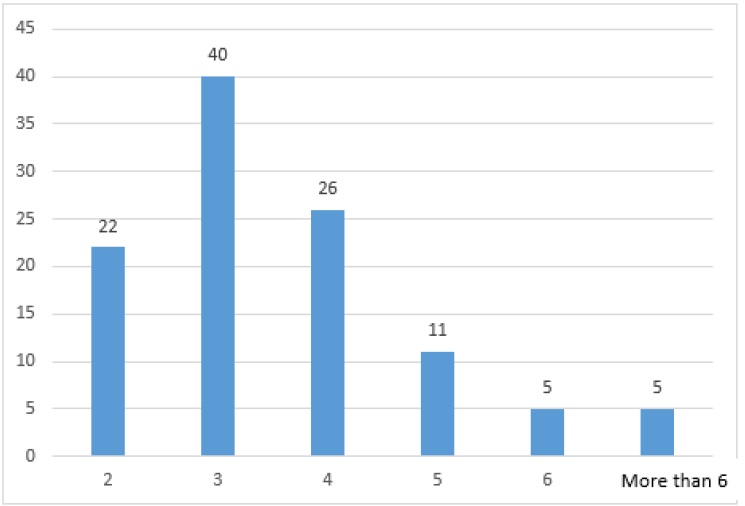
Graph N° 5. Number of notebooks used by students surveyed in a term
Source:Total cases (109 respondents)
It is observed that the 109 students surveyed use 391 notebooks in a four-month period. If we consider that the students attend classes in two four-month periods in one year, they use 782 notebooks during the year. Therefore, the average consumption is 7.17@7 notebooks per student per year.
Regarding the notebooks used, we consider that, if an average student uses 7 university notebooks per year, in tons of paper, they represent:
Tons of paper for each notebook used = 0.00036 (tn/notebook)
Tons of paper for a student's notebooks = 0.00036 * 7
Tons of paper for a student's notebooks in a year = 0.0025
Let us now see what happens with the consumption of paper in photocopying shops and when printing. Regarding the four-month consumption of printed sheets by students, 71% indicated that they use between 0 and 250 printed sheets, 23% between 250 and 500 printed sheets, and only 6% use more than 500 printed sheets.

Graph N° 6. Sheets printed by students in a term
Source: Total cases (109 respondents)
Regarding the use of photocopies, the students surveyed indicated that 43% use between 250 and 500 sheets, 29% more than 500 photocopied sheets, and 28% between 0 and 250 photocopied sheets.
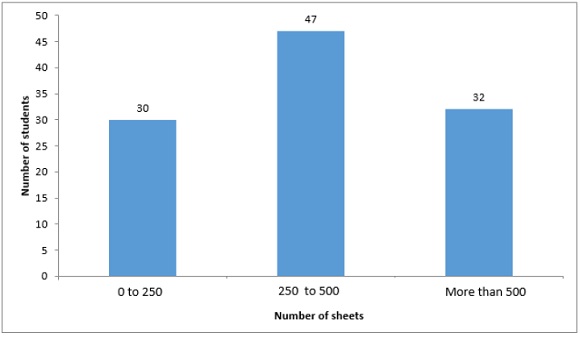
Graph N° 7. Sheets photocopied by students in a term
Source: Total cases (109 respondents)
When comparing the graphs of printed and photocopied sheets, it is observed that the students who took part in the survey photocopy more sheets than the ones they print with their personal printers. Therefore, efforts to reduce the environmental impact of paper consumption must focus on photocopying only what is strictly necessary.
To calculate the paper Ecological Footprint due to the consumption of printed and photocopied sheets, we grouped both four-monthly consumptions in order to calculate the annual consumption of sheets per student. If we combine both consumptions, table 8 is obtained.
Table N° 6. Quarterly consumption of A4 size sheets

Source: Total cases (109 respondents)
In this way, the following average paper consumption per student is calculated based on the results of the survey: 222 sheets of printed paper in a four-month period, so we consider that the consumption is doubled annually (two four-month periods): 444 A4 sheets printed a year. With respect to the photocopied sheets per student in an average term: 416 sheets photocopied in a four-month period, so we consider that the consumption is doubled annually (two four-month periods): 832 A4 sheets photocopied in one year.
Table N° 7. Average annual consumption of A4 sheets

Source: Total cases (109 respondents)
Now we must calculate how many tons the 1276 sheets consumed weigh. For this, we use the factor defined above:
Tons of paper for each sheet used = 0.000005 (tn / sheets)
Annual tons of paper consumed for photocopying and printing per student on average = 0.00638
The annual tons of paper used by a student are thus 0.0088.
Using the annual productivity factor:
Annual productivity (tn / ha) = 1.15 tn / ha
Annual hectares due to a student's paper consumption = 0.01
That is, each student consumes an equivalent of paper converted into an area of 0.01 Ha (100 m2). Although the result obtained does not give much information when analyzed in isolation, it is useful to analyze the three types of paper consumption that students have. The highest consumption is due to the use of photocopies, so the strategic axis aimed at reducing its consumption should be oriented to this type.
CONCLUSION
In the City of Buenos Aires, the largest public means of transport is the bus, as there are many lines and a great diversity of routes. This is manifested in the results of the survey, which shows that 66% of students use this mode of transportation. Only 4% choose non-polluting means (on foot or by bicycle).
First, we carry out an analysis from the point of view of public policies regarding CO2 emissions caused by the use of public and private transport, and we will state possible strategies to reduce GHG emissions based on the 2030 Buenos Aires Action Plan (Lockhart and Gómez, 2009), whose objective was to take measures and prepare for the effects of global warming, oriented to the planning of comprehensive mitigation policies and adaptation to the adverse effects of climate change for the 2010-2030 period. According to the diagnosis made, the current transport situation is characterized by a large number of private cars and a markedly insufficient provision of public passenger transport services.
Considering the population growth by 2030, it is estimated that approximately 3,198,366 inhabitants will be living in the City of Buenos Aires, thus generating a greater demand / use of transport. As the supply of public transport services in the City is insufficient to meet the demand generated, their expansion is a priority to increase the reception capacity of the sector, through public policies aimed at promoting mass transportation and the discouragement to use private cars, which is the most harmful means in terms of GHG emissions. In this sense, it is estimated that strengthening the railway network would prevent the entry of approximately 250,000 vehicles.
The bicycle is the most appropriate means of transport because it does not pollute. Now, would it be then better to cycle everywhere to avoid emissions? Yes, it would, but we would not get rid of the carbon footprint. If the same 8 kilometers calculated for the car, train and bus were covered by bicycle, the carbon footprint would have to be calculated based on what we have eaten, since that food would be the fuel. One burns more or less 50 calories for every kilometer and a half of pedaling. Obviously, cycling or walking becomes the healthiest means for the people who use these means and for the rest of the population due to the lack of emission of pollutants.
All these proposals must be promoted through the Under-secretariat of Urban Planning, Architecture and Infrastructure Projects of the Ministry of Urban Development. However, promoting a modality change in transport requires not only a substantial improvement of public passenger transport services, but also raising the citizens' awareness of the environmental impacts caused by the different means of transport.
The University, like all educational institutions, should promote prevention measures in the field of environmental care, and especially a conscious use of transport, for example, favoring public transport access to university campuses and encouraging the use of bicycles as a means of transport to access them. This must be accompanied by public policies aimed at improving and prioritizing walking, cycling and public passenger transport.
Regarding the consumption of paper by the students surveyed, it is interesting to note that it is mostly used for photocopies, so the so a strategic axis should aim at seek to reduce their use…, using digitized material and, if necessary, recycled paper.
The environmental benefit of using less paper or recycled paper is to preserve the resources needed to make it (cellulose, water and energy) and to reduce the waste generated by disposal.
Therefore, to reduce paper consumption, it is essential to have all the materials digitized. In addition, should anyone want to print any content, they should do so efficiently, that is, double-sided, with the smallest readable font size possible, and checking print margins.
In this way, and in line with the aforementioned recommendations for reduced paper consumption, an action that has been implemented in the Mathematical Analysis II Chair is providing students with the guides and notes of the Chair in a virtual campus.
BIBLIOGRAPHCIAL ABSTRACT
Please refer to articles Spanish Biographical abstract.
REFERENCES
Please refer to articles in Spanish Bibliography.